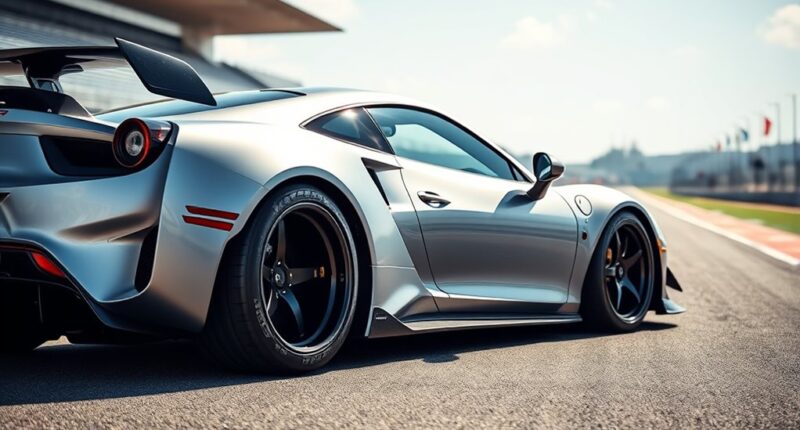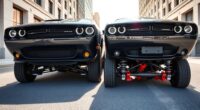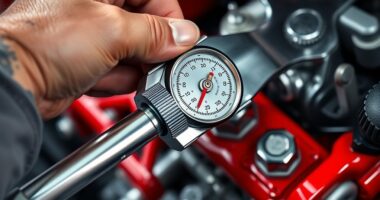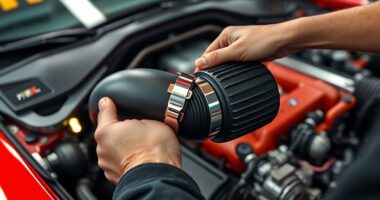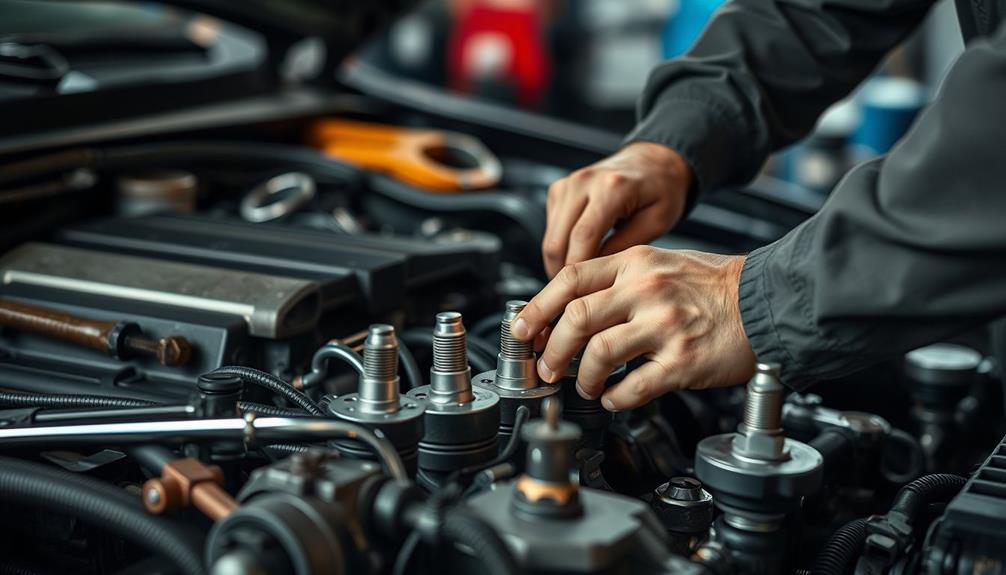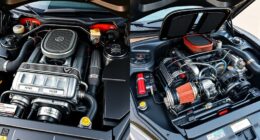To prep for track days, choose the right tires based on your driving style and conditions, like ultra-high performance or R-compounds for maximum grip. Upgrade your suspension and brakes for better handling and stopping power, and consider weight reduction to boost agility. Make sure your vehicle is properly maintained and compliant with safety rules. Using data logs helps you analyze performance. Keep learning the essential modifications and tips to get the most out of your track experience.
Key Takeaways
- Select track-appropriate tires, like Extreme Performance Summer or R-Compound, for optimal grip and durability during high-speed maneuvers.
- Upgrade suspension and brakes with adjustable coilovers, high-performance pads, and rotors to improve handling and heat dissipation.
- Enhance engine output with airflow upgrades, ECU tuning, and cooling systems, while reducing weight with lightweight components for better agility.
- Install safety features such as roll cages, racing harnesses, and fire-resistant gear to ensure driver protection during intense sessions.
- Conduct thorough pre-track inspections, data logging, and review to fine-tune vehicle setup and maximize performance on track days.
Choosing the Right Track Day Tires for Optimal Grip

Choosing the right track day tires is essential for maximizing grip and guaranteeing safety during your sessions. First, consider your driving style and track conditions. Extreme Performance Summer Tires deliver near R-compound levels of grip and are durable enough for track use. R-Compound Tires provide exceptional grip but wear faster, making them ideal for aggressive driving. Track-Specific Tires are designed solely for racing, offering maximum grip but less durability. High-Performance Summer Tires strike a balance, suitable for both street and track. Specialized tires like Yokohama A052 maintain consistent grip throughout wear, making them great for sustained performance. Understanding the importance of tire durability can help you choose tires that last longer and perform better under repeated track use. Additionally, selecting tires with appropriate compound characteristics can significantly influence overall performance and safety. Pay attention to the tread compound, pattern, and heat capacity—these influence grip and longevity. Monitoring tire temperature and maintaining proper pressure also guarantee optimal performance and safety during your track days.
Upgrading Suspension Components for Better Handling

Upgrading your suspension components is one of the most effective ways to improve handling and cornering performance on the track. You’ll reduce body roll and gain better stability during sharp turns. High-quality materials ensure your suspension withstands track stress and maintains consistency over time. Adjustable coilovers let you fine-tune ride height and stiffness, tailoring your setup to specific track conditions. Performance springs with higher spring rates improve responsiveness but can impact comfort if too stiff. Using durable materials guarantees your suspension withstands track stress and maintains consistency. Components like camber plates allow for negative camber adjustment, boosting tire grip and longevity, while upgraded bushings provide better stability. Proper suspension setup is crucial for achieving optimal performance and handling. Options like Bilstein B16 and Ohlins kits offer adjustable damping for precise tuning. Additionally, understanding vehicle dynamics can help you make more informed adjustments to your suspension system. Proper suspension upgrades enhance handling, giving you more confidence and control during every corner.
Enhancing Braking Performance With High-Quality Components

Enhancing your braking performance on the track requires high-quality components that can handle repeated hard stops without fade or loss of feel. Upgrading to race-specific brake pads with high-torque compounds guarantees fade-free braking and consistent pedal modulation. Carbon-fiber ceramic pads reduce dust and noise while maintaining performance. The PowerStop TDBK7359 High Performance Brake Kit offers a comprehensive upgrade with premium materials designed for track use. Upgrading rotors to two-piece designs with advanced alloys and cooling features like slots and drilled holes improves heat dissipation and prevents warping. High-performance calipers, such as multi-piston models, increase clamping force and provide more uniform pressure distribution, enhancing responsiveness. Stainless steel braided lines minimize line expansion, delivering a firm pedal, while high-temperature brake fluid prevents vapor lock during extended sessions. Implementing proper installation techniques and regular maintenance ensure your braking system remains reliable and effective on the track.
Balancing Power and Cooling: Engine Modifications for Track Use

Optimizing your engine for track use involves carefully balancing increased power with effective cooling solutions. Upgrading airflow components like high-performance filters, cold air intakes, and ported heads boosts combustion efficiency and power output. Performance tires also improve grip and handling, which complements engine upgrades by allowing better transfer of power to the road. To handle higher demands, enhance your fuel system with high-flow injectors, reliable fuel pumps, and precise fuel management. Installing a turbocharger or supercharger increases power but also raises heat, so upgrading intercoolers and adjusting wastegates help keep temps in check. ECU tuning and advanced ignition systems optimize power delivery and reliability. Cooling systems like high-performance radiators ensure your engine maintains ideal temperature under stress. Incorporating tuning laws can prevent legal issues and ensure modifications stay within permissible limits. Additionally, considering performance chips can fine-tune your engine’s output for specific track conditions. Combining these modifications prevents overheating, reduces detonation risks, and ensures your engine can sustain its performance during demanding track sessions.
Implementing Weight Reduction Strategies for Improved Agility
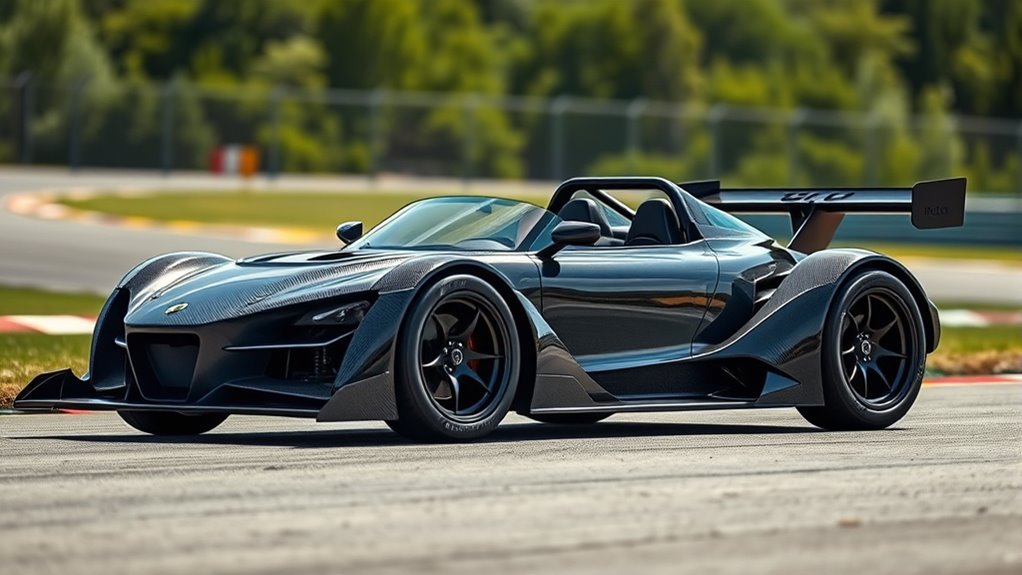
Implementing weight reduction strategies is a fundamental way to improve your vehicle’s agility and handling on the track. By shedding unnecessary mass, you’ll notice quicker acceleration, sharper cornering, and more responsive braking.
Reducing weight enhances agility, acceleration, cornering, and braking for a more responsive track experience.
Focus on lightweight body panels like carbon fiber or composites to cut weight without sacrificing strength. Remove interior features such as air conditioning or soundproofing to save pounds. Installing Lexan windows and gutting doors further reduces weight, enhancing overall performance. Additionally, understanding family dynamics and their influence can help you optimize your approach to modifications, ensuring a balanced and well-rounded tuning process.
Upgrading to lightweight wheels and suspension components like aluminum arms and coilovers decreases unsprung mass and improves handling. A minimalist interior with lightweight seats, carpets, and pedals also contributes.
Lightweight Body Panels These modifications create a more nimble, track-ready car that responds instantly to your inputs.
Installing Safety Features and Reinforcements for Driver Protection

After shedding unnecessary weight to boost your car’s agility, installing safety features and reinforcements becomes a vital step in preparing for track days. You should prioritize high-quality safety harnesses, such as a six-point or five-point system, ensuring they fit snugly and are regularly maintained. Integrate the harness securely with your seat for maximum protection. Proper harness selection and regular inspection are essential for maintaining safety standards. Consider installing a full or half roll cage to add structural strength, especially if you’re aiming for serious racing. Always wear a certified full-face helmet that fits well and is kept clean. Invest in fire-resistant clothing, including racing suits, gloves, and shoes, to shield against fire hazards. Finally, perform vehicle safety inspections before every track session, checking all safety components and adding emergency equipment like fire extinguishers for added security. Incorporating environmental considerations, such as keeping the track area clean and minimizing debris, can also contribute to safety and sustainability during racing events.
Essential Maintenance Checks Before Hitting the Track

Before heading to the track, you need to perform essential maintenance checks to guarantee your vehicle is in top condition. Start by changing the engine oil and filter for peak lubrication. Inspect coolant levels and ensure the system is leak-free to handle high temperatures. Check brake fluid quality and levels, replacing it if degraded. Verify power steering and transmission fluids are topped off for smooth operation. Also, inspect windshield washer fluid for clear visibility.
Make sure to:
- Examine brake pads for wear and replace if needed
- Check brake discs for cracks or warping
- Inspect tires for wear, damage, and proper inflation
- Verify suspension components like bushings and shocks
- Ensure all bolts and fasteners are secure
These checks help prevent failures and maximize performance on track. Routine maintenance is essential to catch potential issues early and ensure your vehicle performs optimally during high-stress driving conditions.
Utilizing Data Logging Tools for Performance Analysis

Have you ever wondered how top racers fine-tune their cars for peak performance? Data logging tools are essential for this. They range from simple GPS apps to advanced telemetry systems that track RPM, throttle position, G-forces, and more. AiM devices support many data sources and provide detailed analysis to help drivers understand their vehicle’s behavior. Many devices connect wirelessly, making data transfer quick and easy, while GPS integration provides precise lap times and location data. These sturdy tools are built to withstand harsh racing environments and offer real-time data collection. During test sessions, live analysis allows you to make immediate adjustments. Post-race, detailed reviews help identify areas for improvement, reducing lap times and boosting performance over time. Choosing the right data logger—whether an affordable app or a complete system—ensures you gain valuable insights to refine your driving and vehicle setup effectively.
Preparing Your Vehicle for Track Day Regulations and Compliance

Making certain your vehicle meets track day regulations and complies with safety standards is key to a smooth and trouble-free experience. Before heading to the track, check that your car has the right safety gear and is properly registered.
Make sure your helmet meets recognized standards like Snell or FIA, and that your safety equipment, including fire extinguishers and seatbelts, passes inspection. Confirm your vehicle’s registration, insurance, and MOT are current, and that it’s free of fluid leaks or modifications that don’t meet event standards.
Both rental and personal cars are permitted, provided they meet safety and compliance standards. Ensure your vehicle has a dedicated tow hook for quick recovery and proper safety features such as a 3-point or higher seatbelt system.
Arrive early with all safety gear installed and ready for inspection.
Tips for a Successful and Enjoyable Track Day Experience

To make the most of your track day, focus on preparation and awareness throughout the event. Wear a Snell-rated helmet, long pants, and closed-toed shoes for safety and comfort. Bring a camera or GoPro to record laps and review your performance later. Organising, Choosing, and Planning Your Track Day helps you understand what to expect and how to prepare effectively for a safe experience. Prioritize a good night’s sleep and stay physically conditioned to handle the demands. Attend all safety briefings and familiarize yourself with the schedule and rules. Before hitting the track, perform basic car checks to ensure reliability. On track, focus on maintaining the racing line, paying attention to flags, and following passing rules. Manage your pace to prevent fatigue and avoid unnecessary wear. Stay hydrated, take breaks, and listen to instructor feedback to improve both safety and enjoyment.
Frequently Asked Questions
How Do I Choose the Best Tires for My Specific Track Conditions?
When choosing tires for your track, you’ll want to take into account the weather and track surface. If it’s dry and smooth, full slicks give maximum grip.
For wet or damp conditions, go with treaded tires with deep channels to prevent hydroplaning.
Match your tire compound to the temperature and surface abrasiveness. Also, think about your driving style and track layout to select the right brand and model for the best performance.
What Suspension Setup Is Ideal for Different Types of Track Surfaces?
For different track surfaces, you should tailor your suspension setup accordingly.
On smooth, high-grip tracks, stiffen springs and anti-roll bars, and lower ride height for better aerodynamics.
On uneven, low-grip surfaces, soften damping, increase travel, and raise ride height to handle bumps.
For mixed or variable conditions, opt for adjustable components like anti-roll bars and multi-stage damping, ensuring your setup adapts quickly to changing surfaces for ideal grip and control.
How Often Should Brake Fluid Be Replaced for Optimal Performance?
You should replace your brake fluid every 6 to 12 months for maximum performance.
After each track day, top off and bleed the brakes with less than 250mL of fluid, especially if you’ve driven aggressively.
Use high-performance fluids like Motul RBF 600 or Castrol, and consider more frequent changes if your driving style is aggressive or if you notice brake fade.
Regular maintenance ensures your brakes stay responsive and reliable under demanding conditions.
What Are the Best Ways to Balance Power Gains With Cooling Needs?
To balance power gains with cooling needs, you should upgrade your cooling system alongside engine modifications. Install high-capacity radiators, high-performance thermostats, and efficient oil coolers to prevent overheating.
Consider intercooler upgrades for turbocharged engines and optimize airflow with heat exchangers and cooling fans. Properly managing heat guarantees your engine performs at its best without risking damage, giving you reliable power and consistent track-day performance.
How Can I Ensure My Vehicle Remains Compliant With Track Regulations?
To keep your vehicle compliant with track regulations, you need to guarantee it has valid licensing, passes the latest MOT, and meets noise and safety standards.
Regularly inspect safety gear, brakes, and tires, and address any leaks or environmental issues immediately.
Make sure your vehicle passes technical inspections, carry proper documentation, and attend mandatory driver meetings.
Staying updated on rules and maintaining your vehicle’s integrity will help you avoid penalties and participate smoothly.
Conclusion
As you prepare for your track day journey, think of your car as a finely tuned instrument enthusiastic to sing. By making thoughtful modifications and paying attention to details, you’ll create a symphony of grip, agility, and confidence. Embrace the process as nurturing a blossoming garden—each enhancement helping your vehicle flourish on the asphalt. With patience and passion, you’ll turn every twist and turn into a memorable dance of precision and adrenaline.
